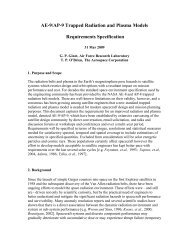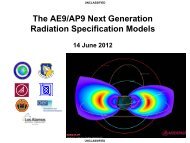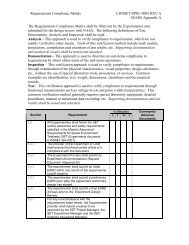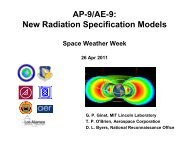Observation of the Solar Particle Events of October ... - IEEE Xplore
Observation of the Solar Particle Events of October ... - IEEE Xplore
Observation of the Solar Particle Events of October ... - IEEE Xplore
You also want an ePaper? Increase the reach of your titles
YUMPU automatically turns print PDFs into web optimized ePapers that Google loves.
DYER et al.: OBSERVATION OF SPEs OF OCTOBER/NOVEMBER 2003 FROM CREDO AND MPTB 3391<br />
TABLE I<br />
MEASURED PROTON FLUENCES >38 MeV cf. CREME96 MODEL<br />
Fig. 7. Integral LET spectrum under 6 mm <strong>of</strong> equivalent aluminum shielding<br />
at <strong>the</strong> peak <strong>of</strong> <strong>the</strong> <strong>October</strong> 28, 2003, event is compared with <strong>the</strong> previous largest<br />
events <strong>of</strong> this solar maximum and with <strong>the</strong> CREME96 worst day.<br />
Fig. 8. One-week rolling averages during <strong>the</strong> period <strong>October</strong> 26, 2003, to<br />
November 6, 2003, are compared with <strong>the</strong> CREME96 worst-week model.<br />
November 5, 2001, have significant heavy ions but are somewhat<br />
below CREME96, while <strong>the</strong> April 15, 2001, event is <strong>the</strong><br />
most intense in heavy ions despite being significantly less intense<br />
in protons.<br />
The occurrence <strong>of</strong> several successive events over <strong>the</strong> course <strong>of</strong><br />
a week or so during <strong>the</strong> Halloween events is a very comparable<br />
situation to that <strong>of</strong> <strong>October</strong> 19–27, 1989, which was used to<br />
create <strong>the</strong> CREME96 worst-week specification. Spectra from<br />
worst weeks around <strong>the</strong> previous events <strong>of</strong> this solar maximum<br />
have all fallen below <strong>the</strong> CREME96 worst week as <strong>the</strong>y have<br />
been isolated events [3].<br />
In Fig. 8 <strong>the</strong> one-week averages for various starting dates<br />
during <strong>the</strong> Halloween events are compared with <strong>the</strong> CREME96<br />
worst week. These have some missing data and are hence lower<br />
limits. The CREME96 worst week is significantly exceeded at<br />
low LET but exceeds <strong>the</strong> latest events at high LET. The low LET<br />
result has been checked using <strong>the</strong> proton monitor with interpolation<br />
over missing orbits and <strong>the</strong> fluences over <strong>the</strong> major events<br />
<strong>of</strong> this solar maximum are presented in Table I. The worst-week<br />
fluence for <strong>the</strong> Halloween week is cm compared<br />
with cm for CREME96. The week <strong>of</strong> November<br />
5–11 is higher but this is highly dependent on interpolated data.<br />
The total measured solar proton fluence greater than 38 MeV<br />
for this solar maximum based on 6.6 years <strong>of</strong> CREDO data is<br />
cm . This does not include <strong>the</strong> event <strong>of</strong> November<br />
9, 2000, which could have added about cm based<br />
on GOES data. It is interesting to note that this total is very<br />
comparable with <strong>the</strong> fluence <strong>of</strong> cm obtained from<br />
<strong>the</strong> JPL-91 model [13] for seven years at solar maximum at<br />
<strong>the</strong> 90% confidence level, calling into question whe<strong>the</strong>r this is<br />
sufficiently conservative. The Emission <strong>of</strong> <strong>Solar</strong> Protons (ESP)<br />
model [14] gives a fluence <strong>of</strong> cm for <strong>the</strong> same<br />
conditions.<br />
It is also <strong>of</strong> interest to compare <strong>the</strong> results <strong>of</strong> Table I with<br />
<strong>the</strong> ESP worst-case event model. For <strong>the</strong> 90% confidence level<br />
this gives worst-case event fluences above 40 MeV <strong>of</strong><br />
cm for a one-year mission and cm for a<br />
seven-year mission. It should be borne in mind that an event<br />
lasts more than one day (typically two) and so <strong>the</strong> CREME96<br />
model is consistent with <strong>the</strong> one-year 90% ESP case. It is also<br />
worth noting that <strong>the</strong> anomalously large event used in <strong>the</strong> King<br />
model and based on <strong>the</strong> event <strong>of</strong> August 1972 gives an event<br />
fluence <strong>of</strong> cm . The MPTB/CREDO-3 data taken<br />
over nearly seven years are consistent with <strong>the</strong> ESP model and<br />
suggest that this model should be employed for proton-induced<br />
SEE using <strong>the</strong> confidence level desired by <strong>the</strong> project.<br />
D. Correlation With Effects<br />
SEEs have been observed in <strong>the</strong> MPTB experiments during<br />
<strong>the</strong>se events and Fig. 9 shows <strong>the</strong> total upset rates observed<br />
during <strong>the</strong> period September 20 to November 5, 2003, in four<br />
16-Mbit NEC DRAMs on board B6 <strong>of</strong> MPTB. The devices used<br />
are those facing into <strong>the</strong> spacecraft as those facing out are experiencing<br />
too much leakage current due to <strong>the</strong> accumulated dose.<br />
The large increase in upset rates during <strong>the</strong> events <strong>of</strong> <strong>October</strong><br />
28 and 29 can be readily seen. In Table II <strong>the</strong> upset rates are<br />
compared with those during previous events and CREDO measurements<br />
<strong>of</strong> proton fluences 38 MeV and ion fluences <strong>of</strong> LET<br />
1.82 MeV/(mg cm ). The results are plotted as histograms<br />
in Fig. 10. All rates and fluences are per device and per orbit<br />
(i.e., 12 hours). The average upset rate for <strong>the</strong> peak day <strong>of</strong> <strong>the</strong><br />
<strong>October</strong> 28–29 events is 179 per device-day compared with a<br />
quiet-time rate <strong>of</strong> 3.1 per device day from galactic cosmic rays<br />
and inner-belt protons. This may be compared with a peak day<br />
rate <strong>of</strong> 225 per device-day during <strong>the</strong> Bastille Day event. A previous<br />
detailed analysis <strong>of</strong> SEU rates during <strong>the</strong> Bastille Day<br />
event showed that in <strong>the</strong> light <strong>of</strong> CREDO measurements and<br />
measured proton and ion cross-sections, <strong>the</strong> ratio <strong>of</strong> ion-induced<br />
to proton-induced upsets was about 2:1 [7]. Note that during<br />
<strong>the</strong> <strong>October</strong> 2003 events <strong>the</strong> fluxes <strong>of</strong> both protons and heavy






